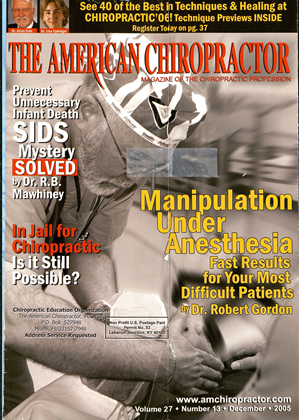THE TIME HAS COME TO SAY GOODBYE, AS THIS IS OUR LAST column of this series for The American Chiropractor. We've discussed a variety of ideas and methods that you can employ to improve your practice. But sometimes we're asked, "If there were just a couple of things, out of all the things you talk about, that you could do to improve your practice, what would they be?" Actually that's a difficult question and, as we usually do, we've chosen to look at it from a somewhat unique angle. Our top three items to make your practice better arc inexpensive and easy improvements in: 1. Compliance 2. Payment 3. Technology Not exactly what you expected? Let us explain. Compliance: When we speak, we are often asked, "What's the best exercise for your patient." Now, that's an impossible question, as there are a number of factors to be considered. But the flippant answer that we usually give, with a smile is, "The one they'll do." You see, there's a lot of truth in that answer—because a frequent complaint is that patients just won't do a home exercise program. But, actually, they will. Now, we all know that home exercise can be a vitally important part our your rehab program, so here are some suggestions to improve compliance. Talk to your patients. We know, you're busy; but a little talking now can save a lot of questions later. Tell you patients that they arc an important part of your health care team and that one of their jobs, which will contribute to the success of improving their problem, is to do their home exercise program. Then, don't give them all their exercises at once. Give them one or two at a time and slowly build up to the program you want. And, remember; keep it as simple as you can. The selection of the proper home exercise program is up to you but, if the patient doesn't do it, then it's worthless. This simple procedure can improve your rehab results. Payment: Now, you want to get paid for all your rehab efforts and we've entered into an era where it seems that everyone wants proof that care is being effective in order for you to receive further payment. Let's face it; you can't rehab a lot of people for free or you'll be out of business. And then what will happen to the rest of your patients? We humans are numbers freaks. We have numbers for everything. So is it any surprise that payers want to see improved numbers in objective outcomes. One of the easiest methods to provide some type of objective information is to use that circular level you bought at the hardware store (look at our previous column that discusses range of motion) and measure the range of motion on the initial examination and at each examination after that. You can then compare the numbers to a chart of normal motion and report the percentage of improvement at each stage of care. Numbers are something that anyone can understand and that includes insurance companies. You deserve to be paid for the rehab work you do and this can help. Technology: We've saved the best for last. The cheapest, effective, piece of rehabilitation technology that we know about is a rolled towel. There was a time (just after the last ice age, when Roger started to practice) that it seemed almost everyone was instructing their patient in the use of rolled towels to help maintain the cervical and lumbar lordoses. Then came all the new things for these areas and a lot of people suddenly forgot how to roll a towel. If there are no contraindications in the case, a patient with a loss of cervical or lumbar lordoses can often obtain a lot of relief from lying supine with a rolled towel under the appropriate area for up to 20 minutes (consider starting with shorter times and working up). While that's great for the patient, it can also save you from being awakened at three in the morning by a suffering patient, and that's great for you. This concludes our stint as intrepid columnists. We hope we brought you some information and perhaps a smile. If you see us at a seminar and liked our column, then be sure to tell Roger. He's the one eating the doughnut. If you hated it, then be doubly sure to tell Roger; but, in that case, he's the one drinking the coffee. Thanks! Note: This information in not intended as healthcare advice. The determination of the risk and usability of information rests Dr. Roger R. Coleman is a 1974 graduate of Palmer College of Chiropractic, practicing in Othello, WA. He is a member of the Adjunct Research Faculty at Life Chiropractic College West, and on the postgraduate faculty of National University of Health Sciences. Dr. StephanJ. Troyanovich is a 1987graduate of Palmer College of Chiropractic, practicing in Normal, IL, and a member of the Adjunct Research Facult}', Dept. of Research, at Life Chiropractic College West. He may be reached at 309-454-5556. EZS
 View Full Issue
View Full Issue






